Victory Shoot: Hanemono in Toy Form
Do you think children should play pachinko, a Japanese gambling game? I certainly don’t, which is why I’m here to make a difference, by buying the Japanese children’s Pachinko machines from the 1980’s and bringing them safely to another continent. No need to thank me, I know I’m a hero. Today, I’m taking a look at Victory Shoot, a toy machine from 1988, the golden era of hanemono machines. An interesting thing is, it’s got something in common with the cutting-edge of 21st century pachinko.
Shoot your way to victory
Back in the Vintage Pachinko article, I took a look at a 1970s Epoch toy pachinko machine. This one was actually sold in the United States; “vintage”-style manually launched pachinko machines had a brief fad popularity in that decade.
Well, toy pachinko machines didn’t stop existing just because Americans can’t handle rotary dial autolauncher controls on their pachinko machines. They just stopped being sold in the US. As far as I know.
That being said, they did get smaller. Here’s today’s machine, Victory Shoot. It’s pretty clear where Yonezawa got the inspiration for the logo and artwork.
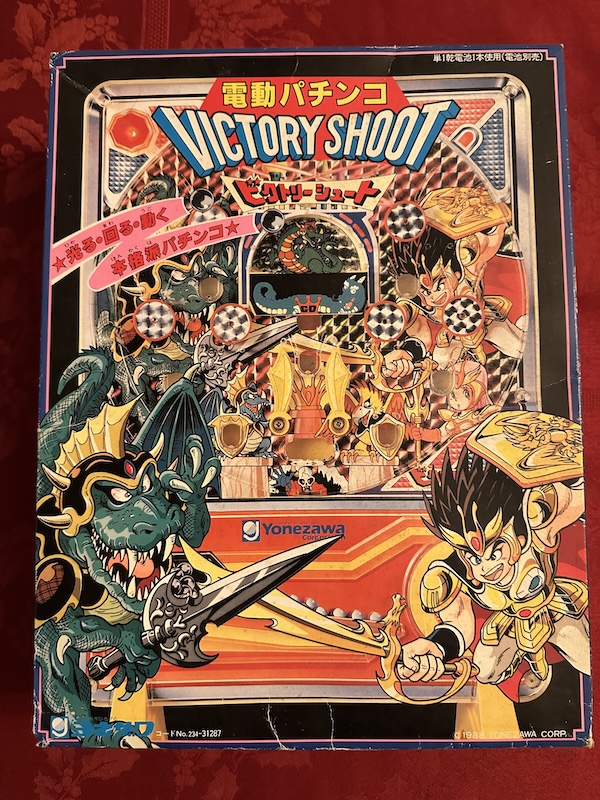
As the label 電動パチンコ (“electric pachinko”) implies, it needs power: specifically, it takes one D-cell battery. Actually, this was a transitional period for battery labels in Japan; it takes either a D-cell or a “UM-1” battery. They’re actually the same thing. Nintendo’s physical Duck Hunt from about a decade earlier just called it UM-1, now it can be either. Today, I believe you’ll only see the “D” label, but I haven’t been to Japan to check.

By the way, you might also be wondering about that speaker grille. Well, it’s not a speaker grille; much like the 1970’s toy pachinko machine, there’s a metal bell. This is an electric pachinko machine, but there’s no electronics in it. It’s fully electro-mechanical.
Enter the machine
Okay, okay, enough of this. Let’s actually get into the gameplay. Insofar as pachinko machines have gameplay. This isn’t exactly a game of skill, is what I’m saying.
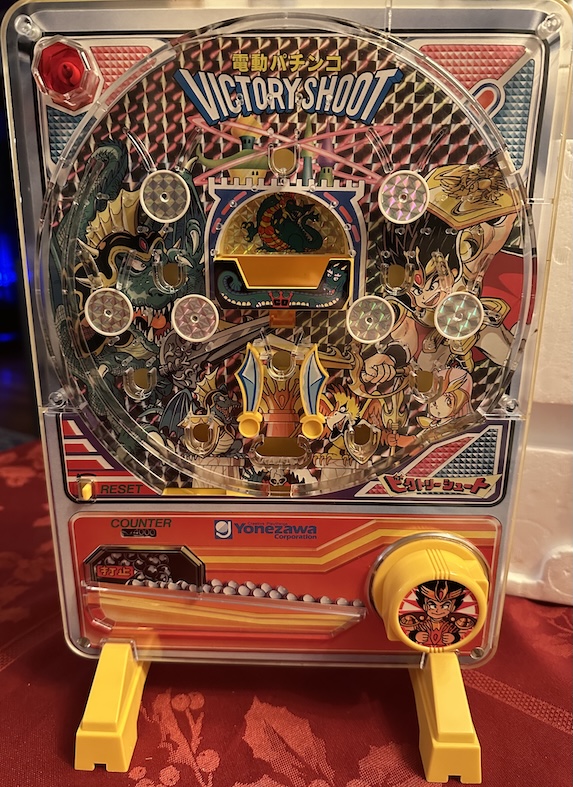
The first thing you’ll probably notice about Victory Shoot is that its front surface, other than the rotary control for the autolauncher, is completely flat. There is nowhere to add pachinko balls; not a tray like even my 2010s Ranma 1/2 hanemono machine had, and not even a single hole like the Epoch toy pachinko. Why?
This is a fully enclosed pachinko machine. The balls recirculate; they are dumped right back into the autolauncher, whether they hit a winning hole or simply drain out the bottom. This is a lot more convenient; no need to keep refilling the top reservoir or trying to figure out a “ball lifter” solution.
So how do you tell the score? We’re well before the era of the battle counter, but Yonezawa introduced one here anyway.
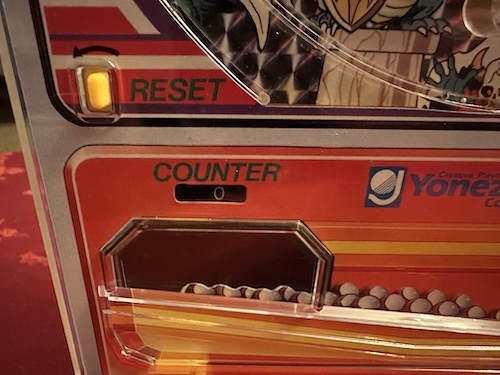
This is just a circular disc that rotates as balls go through the pay pockets. Eventually, at 4000, the disc stops rotating, and reveals the word 打止. This is as far as I can tell short for uchi-dome, which means the machine has dispensed its set limit of balls. This is a feature designed to cut players off, but here it’s just because they ran out of room on the rotating score. The “RESET” switch just sets it back to 0.
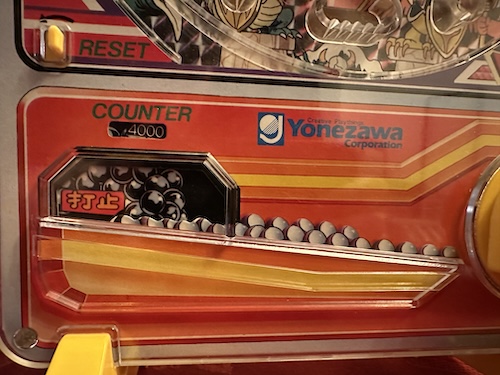
Here’s the full circle. You can see how the “RESET” switch is implemented; a small pawl holds the ratcheting score in place, but when the switch is pulled, the pawl is moved out of the way, and the weak spring pulls the circle back to its regular position.
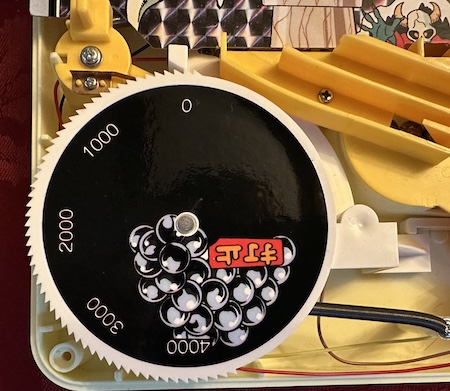
Center yourself
Pachinko machines like this may have other pay pockets, but are all about the central attraction. Interestingly, this isn’t quite a traditional hanemono like my Ranma 1/2 machine. The waving arms don’t give you access to the central attraction, they’re below it.
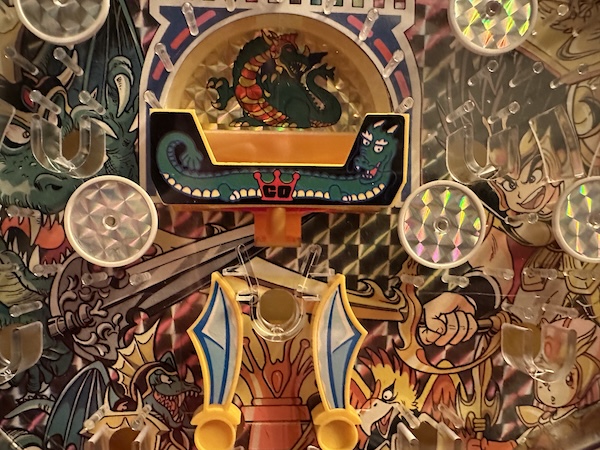
You see that pocket labeled “go”? The goal is to make it through the central attraction, and to get a ball directly there. Once it enters, then the two swords will start waving, allowing balls to enter into the large pocket. It’s not actually that generous of a bonus; it’s still pretty hard to make it work.
And there’s one more challenge to make it harder. Angle!
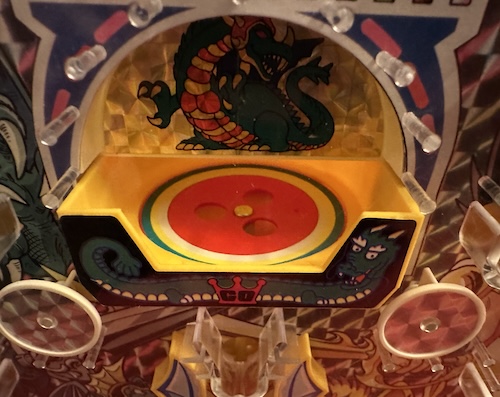
There is a red disc with three holes that is constantly spinning. Only if a ball makes it into a hole aligned with the passage through the front will it actually be deposited in the “go” pocket; otherwise, it’ll just drain.
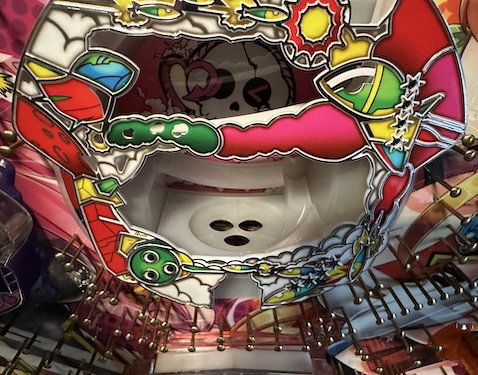
Interestingly, on one of my “real” pachinko machines, CR Moe Excite, there is a similar structure in the center attraction. But on that one, the disc doesn’t rotate. The balls that enter are directed to spin on their own, so it’s not needed. I feel like this makes Victory Shoot a little harder, but then again, there was never any skill involved anyway.
The inside
What’s underneath the plastic lid?
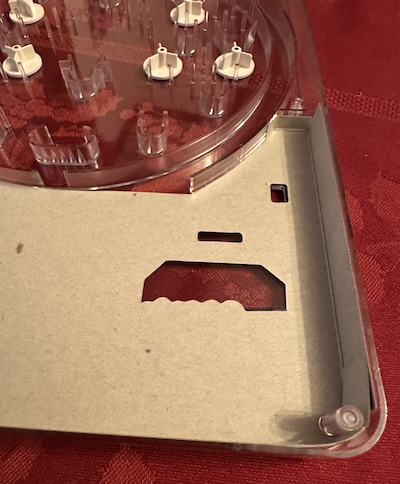
Well, much like the Epoch machine really, all of the art is just printed on cardboard, so I didn’t want to go too far in disassembling things. But I will pause to take a look at the autofiring mechanism underneath that knob.

You might think that the leaf switch there means that this is actually just a switch, and the autofiring mechanism doesn’t actually control how hard the balls fire. But that’s not true; the leaf switch there is actually to control whether the center attraction spins. It stops spinning when you stop firing.
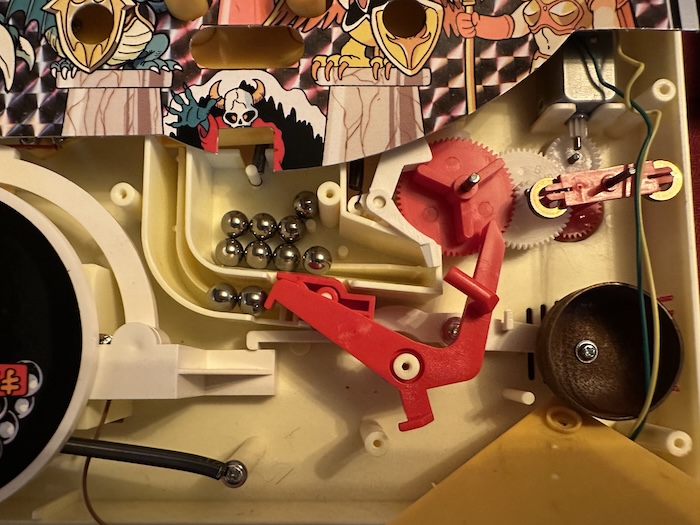
Instead, the key point is that red tab in the lower left. When the knob is in place, there is a spring that attaches to this tab, just like on the Sunsoft SNES pachinko controller. Just like a real pachinko mechanism, the knob doesn’t control the frequency at which balls fire, but just how strong the push is.
One other random detail. See that light in the top corner?
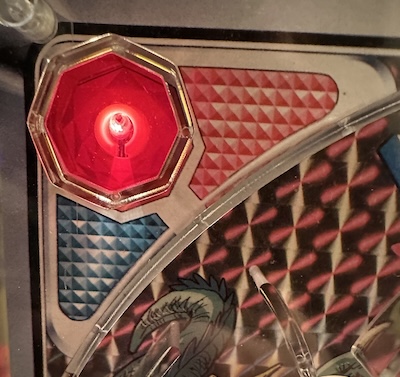
That’s not an LED, but a tiny incandescent bulb. That’s honestly actually a bit surprising for a red light in 1988.
Get Smart
As far as I can tell, in the 1980s in Japan pachinko machines with auto-recirculating balls fell into two categories:
- Toy machines like this one.
- “Medal” games that used pachinko shooters but not traditional pachinko gameplay (Like my Arrangeball machine that I still have)
Real pachinko machines of the ones you used in parlors always had external ball compartments. Indeed, this was the era where always-enclosed arrangeball became external-ball-based arepachi.
But times have changed, and we now have “smart pachinko”. With the realization that in an actual parlor everyone these days is using “ball loan” features, they’re cutting out the middleman and switching to machines that handle that all internally.
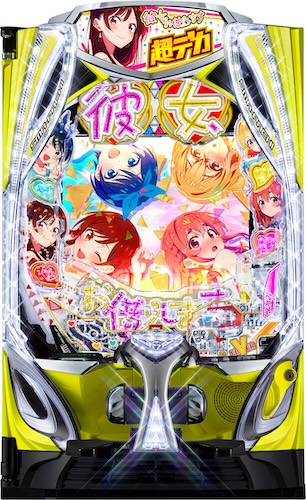
This allows some different form factors, like this Rent-a-Girlfriend machine from Sankyo, which eliminates the ball tray and moves the shooter control to the center.
Of course, the real reason the industry is pushing smart pachinko is that it allows them to get around some of the probability limits placed on regular machines, and for that reason, every smart pachinko on the market right now is a “digi-pachi” based around an internal slot machine. Of course, that’s the vast majority of the pachinko market– the other types are more of a nostalgia market and it makes sense that they’ll be the last to make the switch.
I’m not sure how much the enthusiast community has figured out how to control these machines for home use yet; in theory it seems like they would be better (recirculating mods are very popular in Japan) and I’ve definitely seen people talk about importing them. That being said, the “CR” system that’s been well reverse-engineered is no longer used on these machines.
This is mostly just a glorified aside; I find it a bit amusing that this 1980’s children’s toy is now where the cutting edge of the pachinko market has gone to.
Victory at what cost?
It’s worth noting that there was nothing really special about Yonezawa or Victory Shoot. There were quite a few autorecirculating toy hanemono machines from various manufacturers, like Gakken’s Denpachi series, which are bigger and have more of a traditional hanemono arm layout, but is basically the same concept.

They’re fun toys to mess around with. But that’s all I recommend doing with them; though they’re also a nice way to convince yourself that no, really, hanemono are not skill based.

